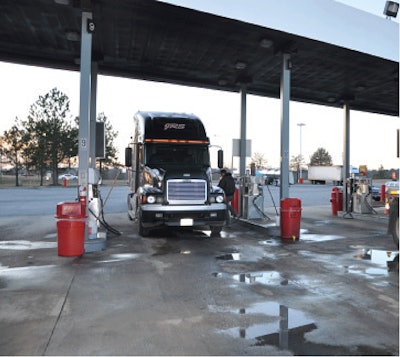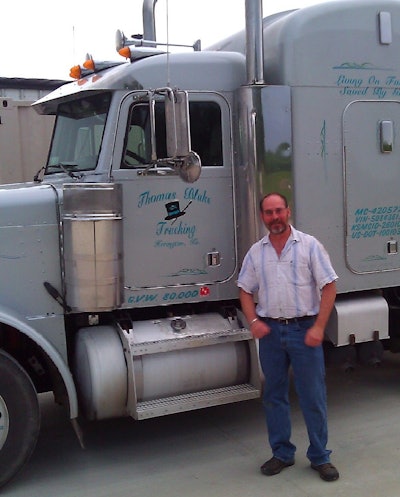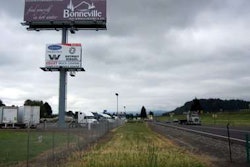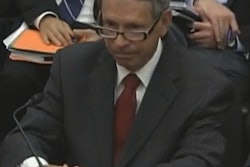
Owner-operator Jeff Clark
I don’t view fuel prices as a huge problem. They require constant efficiency. The more efficient you are, the more you will be rewarded.
Truth about Trucking proprietor/fuel hauler Allen Smith


Personally, I see the Fuel Surcharge Index tool as an excellent way to incorporate a surcharge into your rates, as it takes into consideration daily and not weekly fuel costs.
Smith went on to note that he sees “natural gas in the future” powering a great deal more of heavy-truck transport around the nation, referencing the big partnerships of Navistar and Pilot Travel Centers, among other such partnerships elsewhere in the industry, to boost availability of NG powertrains and fueling infrastructure.
And efficiency, of course. Many fuel additives are available to improve mileage as well as aid in burning cleaner. Reduce idling (when appropriate for the driver), keep up with maintenance, don’t speed, and [for carriers] have well-trained and well-paid drivers. If you take care of your employees, your employee will take care of you.
Schneider National’s Mike Bethea, direct of the owner-operator program
We offer discounts and cost-plus fuel at some of those [chain truck-stop] locations. As an owner-operator, you have to take advantage of those kinds of programs. We all know [price] will go back up, and you can almost follow those spikes in fuel prices and bankruptcies — fuel starts to pass the truck itself as owner-operators’ biggest cost. If you’re getting less than 6 mpg — that’s the minimum acceptable level — if you get less than that you’ve got to have your truck paid off.
A lot of [Schneider owner-operators] have gotten APUs, but we’re also starting to see the environmental laws in states creating a problem because they don’t allow the use of diesel-powered APUs. On these newer Freightliners, we’re getting onboard in the coming year with a newer technology, an electrical system that runs the AC and heats the coolant form the engine [powered solely by batteries]. It works well through that 8-to-10-hour period.
The other thing is the whole natural gas phenomenon — we have some units ourselves that we’ve put on. They’re running all over… They’ve performed very well with lower emissions. That’s the kind of change … that’s necessary, and we may not ultimately have a choice. The first part of some of these tests are very promising.
Owner-operator Don Lanier, leased to expediter J.D. Clark Logistics
It’s tough. At four bucks a gallon it’s hard to watch those numbers spin and the totals be hundreds of dollars. We do get a fuel surcharge built into our trips, though.
I’d like to see some teeth given to the Commodities Futures Trading Commission, which regulates energy futures, but I’m also looking forward to CNG trucks. I will buy one…
I do use perks cards, and an OOIDA Truckers Advantage Fleet One card saves me money at the pump.
Landstar Chief Safety and Operations Officer Joe Beacom
Landstar’s support of its [Business Capacity Owners, or BCOs] relative to fuel is a two-pronged and historically effective approach.
First, Landstar has a very strong fuel discount program that includes all the major chains and many independent locations. The program offers both retail-minus pricing, which offers highly competitive pricing in periods of rising fuel costs, and cost-plus pricing, which provides highly competitive pricing in periods of declining fuel costs. The cost-plus discounts are often significant when compared to the street price.
In 2011, discounts off street price from this program totaled nearly $16 million, all of which was passed through to the Landstar owner-operator who purchased the fuel.
Secondly, we negotiate equitable fuel surcharges with our customers and pass 100 percent of the fuel surcharge we collect from customers to our BCOs. In the first quarter of 2012 Landstar invoiced customers for $71.1 million of fuel surcharges that were passed 100 percent to BCOs.
While alternative fuels are still a long way from the mainstream, especially in the irregular route, long-haul market in which Landstar owner-operators primarily participate, improving fuel efficiency offers the best way to cut fuel costs — after all, the least expensive gallon of fuel is the one you don’t have to buy. To that end, we’ve long offered tips on improving the efficiency of existing equipment — such as the effect of slower speeds and discounts on products like APUs — and have recently launched an effort to help our owner-operators to first understand the advantages of a newer, more-efficient truck and then help them acquire a newer truck through programs facilitated by the Landstar Contractor Advantage Purchasing Program (LCAPP).
Six-truck small fleet owner-operator Thomas Blake

Further, I’ve got all my trucks governed at 70-72 mph. I’ve got Webasto heaters for the wintertime in each truck, which will burn a gallon of fuel a night versus a gallon an hour. I watch the tire pressure.
Blake has installed EOBRs in all his fleet’s six trucks.
With these computers on the trucks to where I can see how fast they’re going, I’ve found that [the old adage about speed and fuel mileage — for every 10 mph over 60 you lose a mile per gallon] is true.
Do you know what your truck costs to run? If you’ve got a truck payment — and insurance payment — without that truck rolling down the road, how much does it cost you? I told a guy leased on to J.B. Hunt…, “You’d be better off driving their truck. You’re probably only making 20 cents a mile after paying their bills.” Owner-operators need to pay attention to what their cost is. If they’re going to deal with all the headaches and they’re not making at least 40 cents a mile in profit they might be better off in a company truck.
Blake on natural gas trucks: I’m reading about them — there’s nothing [in and around Kansas City-area rail yards, where he runs,] yet in terms of fueling infrastructure. The rail yards in Long Beach have them. Everything I’m reading looks good, but we need infrastructure to be in place before we can really switch to it.
Stay tuned for more…














